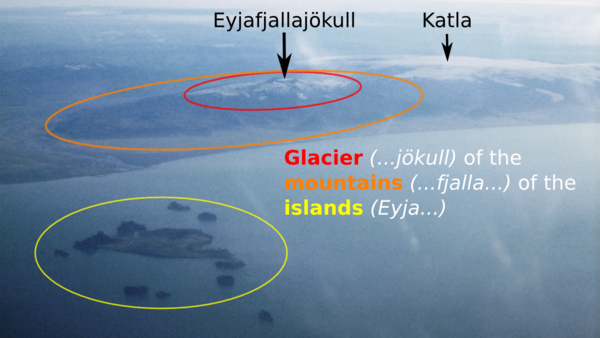
Here is the first picture of Katla that I found to illustrate this post. It was created to show how Eyjafjallajökull’s name comes from the islands offshore, as seen in this view from an aeroplane window. See the source post for details.
Seismic activity has been high at Katla during the past 24 hours. The aviation colour code has been changed from green to yellow (Volcano is experiencing signs of elevated unrest above known background levels) and the Icelandic Civil Protection have declared an Uncertainty Phase (Increased monitoring, research and evalution).
Inevitably, the internet and social media will be awash in a jökulhlaup of doom-mongering click-bait. Ignore it. Here are my recommended sources for information on Katla volcano.
Web
The Icelandic Met Office presents the most up to date monitoring data. Three useful pages are:
- English language home page: Important changes will appear as new articles here
- Aviation colour codes: Katla will change colour if it starts to erupt
- Myrdalsjökull earthquakes: See earthquakes appear in real time
In the event of an explosive eruption, the London Volcanic Ash Advisory Centre, based in the UK Met Office, is responsible for forecasting where an ash cloud will go. They will post updates on their Volcanic Ash Advisories and Graphics page.
The Catalogue of Icelandic Volcanoes is the definitive reference for information about Katla, including the size and frequency of past eruptions.
The Icelandic Civil Protection page has useful information (in both English and Icelandic) for people living in Iceland.
Icelanders are used to eruptions, and their media are far less hysterical than their international counterparts. The Icelandic National News has some English-language articles and set up a dedicated page during the 2014 Bárðarbunga eruption.
Erik Klemetti is a volcanologist working in the USA. His Eruptions Blog reports on volcanic activity worldwide and includes reports on Icelandic activity.
The Icelandic Met Office (@vedurstofan), Civil Protection (@almannavarnir) and National News (@RUVfrettir) are all on Twitter, as is the Eruptions blog (@eruptionsblog).
UK volcanologists doing lots of work in Iceland include @EIlyinskaya, @subglacial, @tephrashard, @JacquelineOwen, @geomorganjones and @htuffen. I am @volcan01010.
It is also worth following @gislio, an Icelandic crisis manager, who tweets lots of relevant information and who set up a list of useful people to follow during the 2014 Bárðarbunga eruption.
The Icelandic Met Office and the Icelandic Civil Protection also have Facebook pages. Much Icelandic volcano monitoring is done alongside scientists from the Institute of Earth Sciences at the University of Iceland. They frequently post results and photos to their news feed.
volcan01010
I’ve been writing this blog since 2011 and have lots of posts about Iceland, volcanoes and ash clouds. Here are a selection that you can read to become an instant Iceland expert.
Katla
- An Icelandic eruption 100 times more powerful than Eyjafjalljökull: Even IF Katla erupts, and even IF it is a powerful explosive eruption, it doesn’t necessarily mean huge disruption in Europe.
- Why people are scared of Katla: A major hazard in Iceland from Katla eruptions is flooding by glacier meltwater (jökulhlaups). This post describes past events and likely future ones.
Ash clouds
- A history of ash clouds and aviation: Every explosive Icelandic eruption since 2000 has affected air travel, but not all cause serious problems.
- How do satellites map volcanic ash clouds?: Satellites are an important tool in mapping volcanic ash clouds. Here is how they do it.
- Grímsvötn 2011: Mapping the plume: Computer models are real-time observations are also important. This post explains how they work.
- UK ash deposition from Grímsvötn 2011 eruption: The Grímsvötn 2011 eruption deposited ash in the UK. This post explains how citizen scientist volunteers helped map where it fell
Other background
- Holuhraun fieldwork videos: The most recent eruption in Iceland produced the largest lava flow in 200 years. Here videos from my fieldwork there.
- Gas, not ice, makes subglacial rhyolite explode: This post explains what makes an eruption produce ash (explosive) or lava (effusive) and how glaciers can affect this.
- Sounds of the Underground: Much of our information about what goes on beneath volcanoes comes from study of volcanic earthquakes. This post lets you ‘hear’ what they are like.
- Do Iceland’s volcanoes pose a threat to the UK?: Video of a lecture that I gave in 2014 at the Geographical Association Annual Conference.

